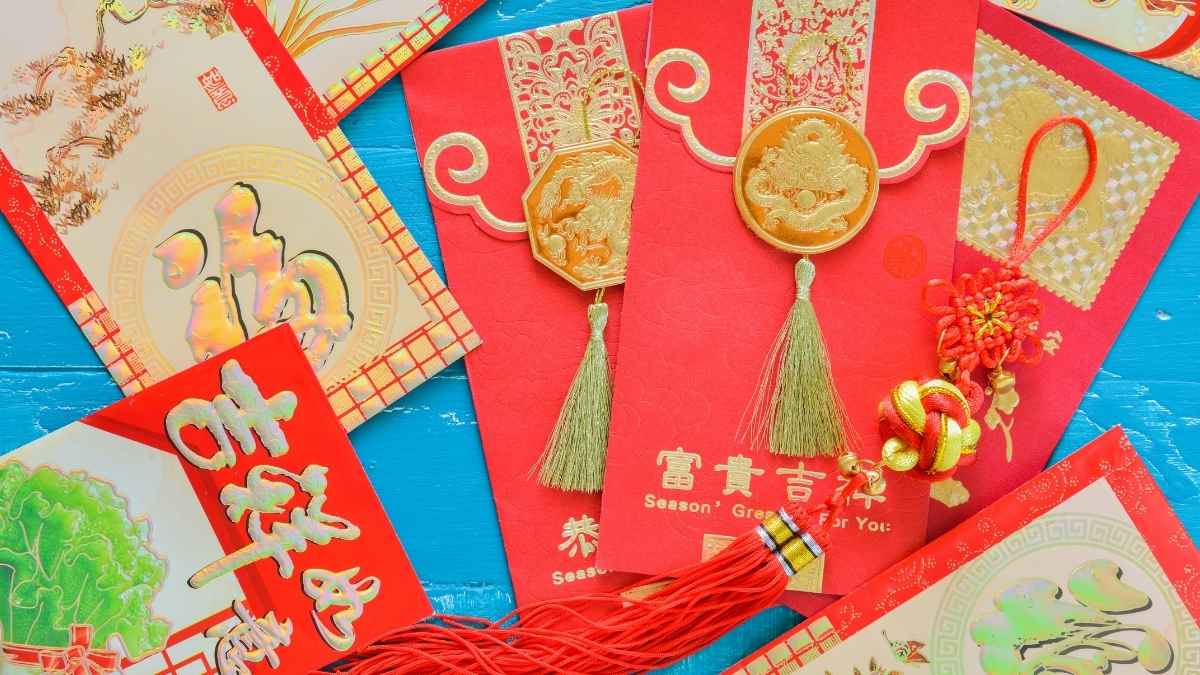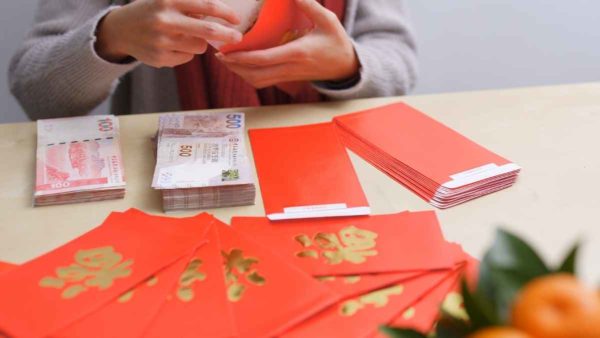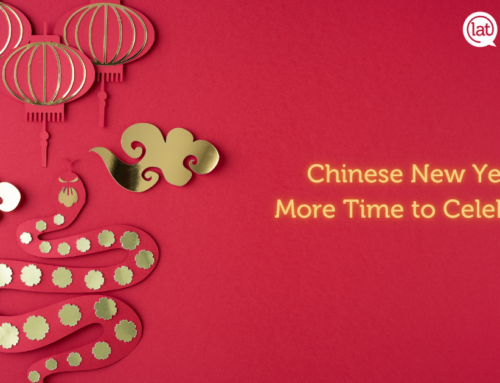During Lunar New Year, it’s very common for Chinese people to give the gift of a red envelope (known as 红包, hóngbāo in Mandarin, or 利是, lai-see in Cantonese) to friends and family. These long, narrow envelopes are filled with money and symbolize good wishes and luck for the new year ahead. While hóngbāo is used in Chinese-speaking communities, “hangpao” is common in Southeast Asian countries like Malaysia, Singapore, and the Philippines.
What does the colour red symbolize in Chinese Culture?
Red represents fire and is a symbol of joy, happiness, success, and good fortune. Red decorations are widely used during many important cultural festivals and significant events such as weddings. In relation to Chinese New Year, the colour red is linked to various myths. The most popular legend tells the story of Nian (which sounds the same as the word ‘year’ in Chinese), who would appear every New Year’s Eve to eat crops, livestock and even children. Villagers learned that this half-bull creature with a lion’s head was afraid of fire, noise and the colour red. To scare the monster away, people displayed red paper, lit candles and wore red clothes during Chinese New Year. These traditions have continued in China and around the world until the present day.
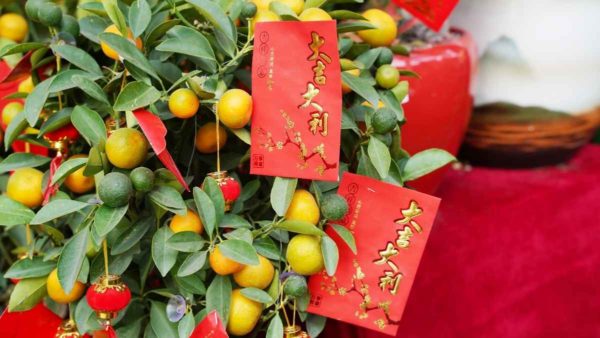
Why do people give red envelopes during Chinese New Year?
The significance of the hóngbāo is actually the envelope itself, rather the money inside. The custom of giving red envelopes originates from another Chinese New Year legend about a demon named ‘Sui’. The mythical monster would come and pat children’s heads while they were sleeping, resulting in the children being scared and developing a high fever. This led to parents trying to keep their children awake all night on New Year’s Eve to protect them from Sui. Legend has it that on one particular year, a child was given eight coins to play with to keep him awake throughout the night. He eventually fell asleep with the coins resting on his pillow. However, when Sui appeared and tried to pat the child’s head, the coins produced a powerful light that frightened the monster away. It is believed that the eight coins were the Eight Immortals in disguise, another important story in Chinese mythology.
The practice of giving red envelopes is prevalent in several cultures that celebrate the Lunar New Year, including:
- Chinese communities worldwide: Red envelopes are given to children and unmarried adults as a symbol of good luck and to ward off evil spirits.
- Vietnam: Known as lì xì, red envelopes are given during Tết, the Vietnamese Lunar New Year, to bring good fortune.
- Korea: During Seollal, the Korean Lunar New Year, money is often given in colourful silk bags called bokjumeoni.
Tips for giving red envelopes to Chinese clients
Traditionally, red envelopes were given from members of the older generation to the younger generation. Today, however, these gifts are given to various people including friends, family, colleagues and even casual acquaintances. This upcoming Lunar New Year, connect with your Chinese clients by gifting them a red envelope to show that you acknowledge and care about their customs and traditions.
- Although the envelopes should always be red, consider giving envelopes with different designs on them. This allows you to use each design for a certain denomination of money. For example, red envelopes with a tiger on them could hold $100 and red envelopes with a lantern on them could hold $50. This allows you to be able to tactfully discern how much money you are giving to each person.
- It is customary to only give new, clean and crisp bank notes as this Chinese New Year gift carries blessings for a new start along with the new year.
- Keep luck on your side. Although there are no specific rules for the amount of money that should be in each envelope, we recommend giving denominations of cash using traditional lucky numbers such as 6 or 8. For example, $60 or $80.
- Luck money should not be given in fours. Avoid giving denominations such as $40, $400, and $444. This tradition has linguistic roots, as the pronunciation of the Chinese word four (四 sì) is the same as the word death (死 sǐ).
- Send a WeChat red envelope. In recent years, many people have become accustomed to exchanging digital red envelopes instead of traditional paper ones. WeChat allows users to send virtual packets of cash that are transferred directly to someone via smartphone.
- Host a WeChat red envelope lucky draw. You can post ‘group red packets’ within a WeChat group to give your followers a chance to win. The app will then automatically and randomly assign the amount in each envelope to each recipient within the group. You don’t need to give away large sums of money here, it is just a fun and enjoyable way to engage with your Chinese customers on social media. While RED (Xiaohongshu) continues to grow in popularity, sending red envelopes on the app isn’t possible. Digital red envelopes are usually given and deposited in WeChat Wallets.
- Retailers can embrace Lunar New Year (LNY) celebrations both in-store and online through various strategies:
- In-Store Celebrations:
- Thematic decorations: Adorn the store with red lanterns, couplets, and other traditional Lunar New Year decorations to create a festive atmosphere.
- Special promotions: Offer discounts or special promotions on products that are popular during the Lunar New Year, such as gift items or traditional foods.
- Online Engagements:
- Festive website design: Update the website with Lunar New Year themes and banners to reflect the celebration.
- Digital red envelopes: Implement digital red envelope giveaways or discounts to engage online customers.
- Social media campaigns: Share content related to Lunar New Year traditions, behind-the-scenes preparations, or customer stories to connect with the audience.
- In-Store Celebrations:
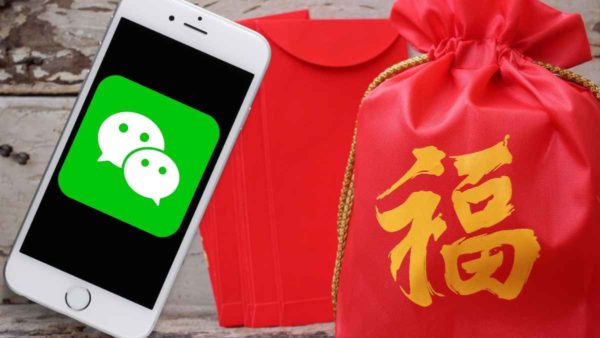
The Year of the Snake holds significant meaning in Chinese culture. The snake is associated with wisdom, intuition, and transformation. People born in the Year of the Snake are believed to be intelligent, graceful, and strategic. The snake’s ability to shed its skin symbolizes renewal and the ability to start anew, making it a potent symbol of personal growth and development.
In 2025, the Year of the Wood Snake begins on January 29.
Many people across Canada and the United States commemorate Chinese New Year by gifting bright and beautiful red envelopes to their employees and clients. To learn more about Chinese holiday marketing strategies tailored to your business, contact us! Our Chinese marketing experts would be delighted to help.

